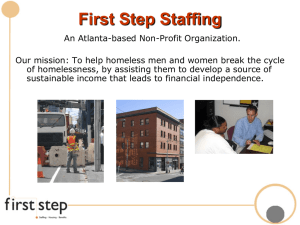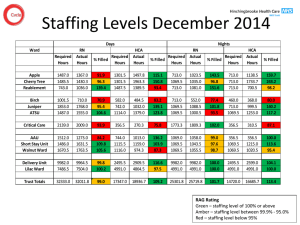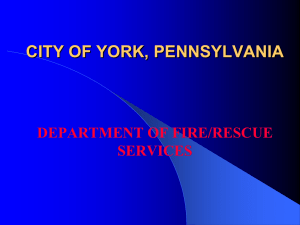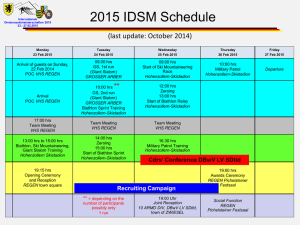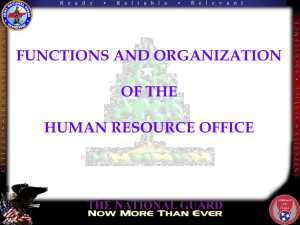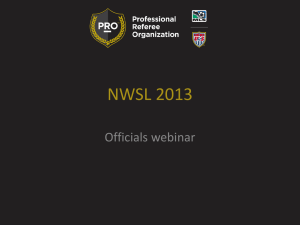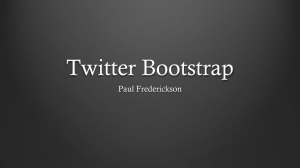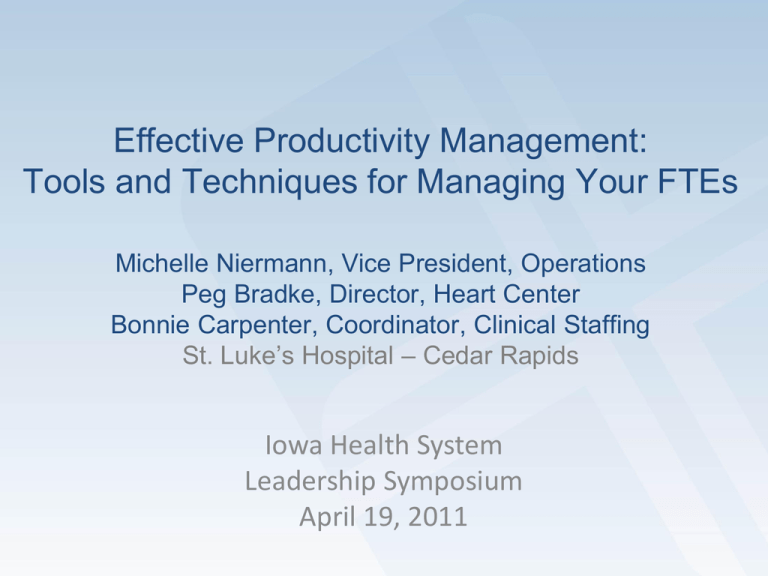
Effective Productivity Management:
Tools and Techniques for Managing Your FTEs
Michelle Niermann, Vice President, Operations
Peg Bradke, Director, Heart Center
Bonnie Carpenter, Coordinator, Clinical Staffing
St. Luke’s Hospital – Cedar Rapids
Iowa Health System
Leadership Symposium
April 19, 2011
Productivity Management at St. Luke’s Hospital
• Early 2000s
– Use of Hours per Patient Day (HPPD) as Productivity Measure
for Inpatient Nursing Units
– Participation in Iowa Health System’s Lane Benchmarking Effort
• Mid 2000s
– Period of Solid Revenue Growth and Solid Operating Margins
– Bi-Weekly Productivity Reports Include Focus on Worked FTEs
and Worked Hours per Unit of Service
Productivity Management at St. Luke’s Hospital
• 2007
– Softening of Operating Margin; Heightened Attention on
Productivity
• Decision Not to Focus on External Benchmarking but Rather
Daily Management of Staffing
• Recognition of Staffing as One of a Few “Big Q” Processes
Year
Net Revenue
FTEs
% Change
% Change
2005
$210,744
1821
2006
$234,045
1944
11.1%
6.8%
2007
$238,283
2041
1.8%
5.0%
2008
$262,677
2047
10.2%
0.3%
2009
$279,889
1988
6.6%
-2.9%
2010
$295,864
2005
5.7%
0.9%
Productivity Management at St. Luke’s Hospital
• 2008
– Intensive Focus on In-Quality Staffing
– Greater Use of Existing Bi-Weekly Productivity Reporting
– Greater Use of Worked Hours per Unit of Service to Develop FTE
Budgets
• 2009-2010
– Continued Refinement of In-Quality Staffing
– Investment in One Staff as a Productivity Management Tool
– Introduction of Productivity Coaches
Productivity Management: The Visual History
CMI Adj. FTEs/AOB
2007-2011
5.00
4.80
4.60
Actual
4.40
Budget
4.20
4.00
3.80
Jan-07Mar-07May-07Jul-07Sep-07Nov-07Jan-08Mar-08May-08Jul-08Sep-08Nov-08Jan-09Mar-09May-09Jul-09Sep-09Nov-09Jan-10Mar-10May-10Jul-10Sep-10Nov-10Jan-11
Productivity Pulse Question
My understanding of the productivity statistic
“CMI-Adjusted FTEs per AOB” is:
a) Crystal clear
b) Fairly solid
c) A little hazy
d) I’m sorry, what was that you said?
Productivity Management: The Visual History
Biweekly FTE Variances - 2007-2011
250
200
150
FTEs
100
50
-
(50)
(100)
(150)
Productivity Management: The Visual History
Patient Care Division Improvements
7.0%
6.0%
5.0%
4.0%
3.0%
2.0%
1.0%
0.0%
2005
2006
2007
% OT to Worked Hours
% Orientation to Worked Hours
2008
2009
% Extra Hours to Worked Hours
2010
Productivity Management at St. Luke’s Hospital
• The Team
– Peg Bradke, Director, Heart Center
– Bonnie Carpenter, Coordinator, Clinical Staffing
– Mary Hagen, Administrative Director, Organizational
Effectiveness
– Jenn Eubanks, Senior Decision Support Analyst
– Scott Kallemeyn, Director Business Operations, Surgical Services
– Leigh Christensen, Administrative Fellow
In-Quality Staffing
Peg Bradke
Director, Heart Center
Kick off March 4 2008
Goal: To adjust staffing and demand
scheduling toward 95% In-Quality Staffing,
using Rapid Cycle Testing.
10
Productivity Pulse Question
In your environment, what would you rank as the
chief factor negatively impacting your productivity?
a) Overtime
b) End of Shift Overage
c) Volume Fluctuations.
d) Inappropriate Matching of Worked Hours to
Volumes
e) Not Sure
St. Luke’s Cedar Rapids Summation
100-Day In-Quality-Staffing
“95% In Quality Staffing”
Kick-off:
30-day check-in: May
60-day check-in: Deferred due to flood
90-day check-in: August
–
Summation Year End
In Quality Staffing Analysis
29
4.1
3.9
Out of Quality
3.5
19
95% In Quality Range
3.3
14
9
3.1
UOS/FTE/Hr
3.7
2.9
Out of Quality
2.7
4
2.5
78
89
910
10
-11
11
-12
12
-1
12
23
34
45
56
67
78
89
910
10
-11
11
-12
12
-1
12
23
34
45
56
67
UOS & Staffing
24
© 2005 Chip Caldwell & Associates, LLC. All Rights Reserved.
SMJC – IQS 0307-13
14
30 Day Goals of Report Out
1. Describing rapid cycle test(s) related to staffing you had
completed pre-flood and how you're doing holding any
successes you had
2. Describing rapid cycle test(s) related to staffing you still plan
to pursue
3. Describing any staffing innovations you tried out of necessity
during the flood that you may look to continue
4. Describing your 1-2 best waste / cost reduction ideas
implemented or planned
100 Day Report Out IQS Objectives
1. Describe your departmental IQS staffing results
from the latest collection period (Nov. 9-22) and
plans for sustaining or improving In-Quality staffing
levels into 2009. Report 5-7 minutes.
2. Address any sustained results from your earlier
staffing adjustments made either prior to or during
the flood, or due to previous rapid cycle tests
3. Repeated Hourly data collection for departments
with greater than 20 FTE
3 West – May 2008
17
3 West - December 2008
In Quality Staffing
My Department
30
25
Staff/Volume
20
15
10
5
0
7-8
8-9
9-10
Wtd Pts
10-11
11-N
Staff
N-1
1-2
2-3
ADT Volume
3-4
4-5
Pts/Staff/Hr
5-6
6-7
7-8
U-IQS Range
8-9
9-10
10-11
Lower IQS Range
11-M
M-1
1-2
2-3
3-4
4-5
5-6
2008 Themes and Next Steps
• Themes
–
–
–
–
Reducing Overtime
Reducing End of shift overage
Reducing Extra Hour Incentive
Monitor Non productive time
• Next Steps
– Carry forward improved performance results in 2009
Budget Development
– Repeat Hourly monitor for pp2 2009
– Emphasis on daily entries in Kronos
January 2009 Report out Results
• Developed a new tool for daily monitoring
• Set up system to assure correct time schedules were
in Kronos so OT and worked hours would be
calculated appropriately
January 2009 Report out Results
New Tool for Daily Monitoring
Daily In-Quality Worksheet Calculator
Pay Period
Unit
Units of Service (e.g. #
visits, procedures, contact Worked
hours, OR minutes)
Hours
Sunday
Monday
Tuesday
Wednesday
Thursday
Friday
Saturday
Sunday
Monday
Tuesday
Wednesday
Thursday
Friday
Saturday
Totals
0
Wkd Hrs/Unit of
Service
Met Target Y/N
#DIV/0!
#DIV/0!
#DIV/0!
#DIV/0!
#DIV/0!
#DIV/0!
#DIV/0!
#DIV/0!
#DIV/0!
#DIV/0!
#DIV/0!
#DIV/0!
#DIV/0!
#DIV/0!
0
#DIV/0!
Units of Service
Works Hours
Wkd Hrs / UOS
Orientation Hrs.
Educ. Hrs.
Mtg Hrs.
Comments
YTD ACTUAL 2009
BUDGET 2009
YTD 2008
YTD 2007
YTD 2006
2009
2008
2007
2006
Call Hrs.
OT Hrs.
% OT/wk hrs Ex Hr.
% Ex.
Hrs./wk hrs. PL Hrs.
2009 Themes and Next Steps
• Themes
– Introduces new actions plans related to bedside
report and cross training.
– Using PA to address OT issues
• Results / Next Steps
– Year ended strong
– Start of 2010 started out poor
– Set up March 2010 report out
2010 Report Outs
• March- New form, using One Staff to assist
• August - Set new plan to concentrate and
report outs from departments running less
than 95% productivity.
• November – Started coaching for departments
at less that 95% productivity
3C
11.1
2010 Budgeted HPPD:
HPPD
Pay Period 22
Pay Period 23
Pay Period 24
Pay Period 25
YTD
OT Hrs
Extra Incentive Hrs
12.4
12
81
167
53
98
11.5
64
150
13.7
11.7
18
12.2
36
75
Comment on your 2010 productivity performance and any action you
took to improve that performance:
Orientation is running 1 FTE higher than budgeted due to vacancy and orientation to the new aquaphoresis technology.
This all happened in the 2nd quarter and 3C has not been able to balance that out. If that out of the ordinary orientation is
taken out 3C would be at 11.8 for the year.
PP 24 was seeing improvements. PP 25 43% of the time 3C was at a census of 14 or below. At that level for safe census
and coverage of telemetry monitors the unit cannot be within productivity levels and this negatively impacted the pp.
Describe your productivity action plan for 2011:
Will continue working with Director re: coaching on productivity. Meeting with Peg Bradke 12/16 for increased productivity
education. Education done with unit Secretary on importance of early morning payroll input for monitoring with OneStaff.
Work with staff 1:1 with end of shift outliers & early punch ins. Use adaptive design observations for end of shift
monitoring. Encourage alternatives to 1:1 if an option
St. Luke’s CR—Onestaff
Bonnie Carpenter
Coordinator, Clinical Staffing
How we are using Onestaff to
Monitor Productivity
Productivity Pulse Question
How frequently does your department receive
productivity reports/ data?
a)
Greater than once/ day
b)
Daily
c)
Weekly
d)
Every payperiod
e)
Monthly
Ramping it up in 2010
Creating a Culture Change—
Moving toward Prospective Productivity
Reporting
Using our IHS affiliation to look for Best
Practices—and borrowing shamelessly…
• Use OneStaff to create a Productivity
Report for every shift.
• Generate a weekly Productivity Report
every Monday to give Managers an idea
of how they are doing midway through
the payperiod.
• Provide coaching to those who need it.
What is OneStaff?
• It’s owned and operating at every IHS affiliate
hospital
• Employee Database
• Scheduling
• Daily Staffing
• Reporting
• Productivity
At the Core--The Interfaces
Kronos
Care
Cast
Infinium
OneStaff---how it works…..
• The Department’s budgets and schedules are
entered into Onestaff.
• OneStaff interfaces with CareCast to bring in
the census.
• Based on the census and the staffing data
that comes from the unit’s schedule,
OneStaff can predict if staffing will be within
budget on a given shift.
• Interfaces with Kronos to bring in the actual
hours worked.
Set up For Productivity Reports
Elements required:
– Budgeted FTE’s
– Orientation FTE’s
– Nonproductive Factor
– Account for Other Nonproductive hours
– Budgeted Units of Service
Diagnosing the Problems—
the 5C Story
• Off to a bad start—87%
productivity in week
one.
• Coaching
• Using OneStaff to
diagnose staffing issues
• Creating a correction
plan
5 Center Productivity 2011
115%
110%
105%
100%
95%
90%
85%
Goal
80%
Productivity
75%
70%
65%
60%
55%
50%
1
2
3
4
5
6
7
8
Attending to the little things—
the 4W Story
4 West Productivity 2011
105.0%
100.0%
95.0%
90.0%
Goal
Productivity to Target OS
85.0%
80.0%
75.0%
70.0%
1
3
5
7
9
11 13 15 17 19 21 23 25
What is happening in Respiratory
Therapy????
Resp Therapy Productivity
110.0%
100.0%
90.0%
80.0%
Productivity
Goal
70.0%
Productivity to
Target OS
60.0%
50.0%
1
3
5
7
9
11
13
15
17
19
21
23
25
Accounting for all their activity….
•
•
•
•
Pulmonary Function Lab—52hrs/wk
Crit Care and NICU Competencies
Unit’s Education, i.e. STEPPS
ICU and NICU Multidisciplinary Rounds—24
hours/ week
• These activities had to be built into the 2011
budget—3.6 FTE’s
Future Goals
• More departments will monitor productivity
in OneStaff
• Implement Web Reporting in 2011
• EPIC interfaces will bring in workload data for
both nursing and ancillaries.
• Affiliates will continue to cooperate,
standardize Units of Service, and potentially
benchmark against each other
Key Themes – For Departments
• Monitor staffing real time and calculate HPPD or Worked Hours per
Unit of Service on a daily basis. Develop action plan for flexing staff
concurrently if volumes rapidly decline.
• The schedule should match the budget
• Differentiate your schedule from your day to day staffing
• Engage staff in the discussion of productivity targets
• Address general overtime utilization and end of shift overtime
• Revise Orientation/Learning methods
• Look for ways to utilize cross training
• Assure schedule options in Kronos are appropriate for the clock in
and clock out times.
• Share best practices and compare interventions across departments
Key Themes – For Organizations
• Strengthen the Core Team / Administrative Focus
• Ongoing Use of In-Quality Staffing Report-Outs
• Increasing Use of One Staff as a Productivity
Management Tool
• Productivity Coaches
• Frequent Reporting
– One Staff Daily, Weekly and Bi-Weekly Productivity Reports
– Bi-Weekly Productivity Report Produced by Finance
– Inpatient Nursing Unit Trend Report, also now Produced by
Finance
– Monthly CMI-Adjusted FTEs per AOB
• Top-Down FTE Budgeting / Tie to Daily Staffing
Next Steps for Productivity
Management at St. Luke’s Hospital
• Continued use of the In-Quality Staffing approach and of
productivity coaches
• More fully deployed use of master staffing plans and grids
for all unit-of-service-driven departments
• Broader use of One Staff within St. Luke’s and, with Iowa
Health System support, expanded capabilities of the One
Staff system
– Web Reporting
– Epic Interface
• Productivity benchmarking in select departments,
preferably starting within the Iowa Health System,
facilitated by standard unit of service definitions (Finance
Departments) and expectations for dialogue at the affinity
group level (Chief Operating Officers)

